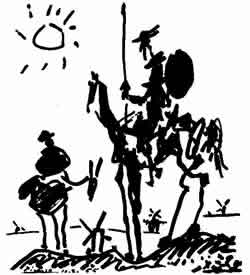

In 1605, four-hundred years ago, Miguel de Cervantes published in Spain the first modern novel, Don Quixote. In 2002, a panel of one hundred writers from around the world, including several Nobel Laureates, voted it the best work of fiction ever written, in a poll organized by the Norweigian Nobel Foundation[1]. It is not surprising, then, that every year thousands of middle school, high school, college (or university), and graduate students around the world read this masterpiece of world literature. Whether they read the original Spanish text, adaptations, or translations, many of them struggle with vocabulary issues, with what is seen awkward wording, with intertextual references that require great background knowledge to fully understand, and ultimately with staying engaged.
The first chapter of the novel is one of the shortest, but still presents challenges to the modern reader. In it, the gentleman Alonso Quijano (or Quixada or Quesada) is described, and the story of how his brain got dry and he lost his wits by reading books of chivalry from sunrise to sunset is told. The chapter is filled with references to the life of seventeenth-century Spain (with many lexical references) and to books such as Amadis of Gaul, The Cid Ruy Díaz, Palmerin of England, and other stories of knights-errant.
This lesson is based and elaborates on three introductory lessons to Don Quixote, one designed for native speakers of Spanish, and two for students of Spanish as a foreign language. The first, "La ociosidad productiva de don Quijote (capítulo I)" by César López Llera can be found at profes.net, a network of teachers of Spanish. It proposes to guide students to reflect upon the character of Don Quixote (his physical description and his foolishness), the title of the chapter, and the region of La Mancha. It relies primarily on printed text, an Internet resource, and class discussions. The second, An Introduction to Don Quixote, by Bonnie Eisenberg is one of the curricular resources from the collection of the Yale-New Haven Teachers Institute. It uses a translation of the text into English (with simplified language) and the Spanish version to familiarize students with the story of Don Quixote, his physical characteristics and portions of the text in both English and Spanish. The third lesson, "La Razón de la Sinrazón" by Agustín Yagüe can be downloaded from the Elenza (Enseñanza de la Lengua Española en Nueva Zelanda Aotearoa) website, and it was designed with support from the Spanish Ministry of Education. It is a reading comprehension lesson that uses fragments of an adaptation of the text in Spanish to teach vocabulary, verb conjugation in Spanish, descriptions of people and things, and markers textual organization (mainly adverbial clauses). All three lessons rely heavily on the print version of the text, providing little to no scaffolds for students other than recommendations for the teachers to clarify vocabulary, ask guiding questions and lead full-class discussions.

Specific deficits related to ADHD may cause that students who suffer of this disorder may find it difficult to learn. Even though it is difficult to generalize, students with ADHD are thought to suffer mostly of deficits with executive functions (strategic networks located primarily in the frontal part of the brain). They have trouble holding information in memory, self-directing their actions, controlling emotions and breaking down behaviors into smaller parts and then recombining them into new actions Barkley (1998, p. 70). Students with ADHD may have trouble derived from memory deficits. When reading, it is crucial to keep information in memory (from tracking nouns and pronouns to descriptions to elements of the storyline). Readers must know which aspects of the texts they should pay most attention to, such as focusing on the action in one part of a novel, to focusing on the language of a description in another. They must move from focusing attention on one aspect of the writing to focusing it on another.
They might also have deficits related to recognition networks, such as maintaining visual attention, discriminating various visual inputs, and changing the focus of their attention (Bower, 2003, p. 339). Maintaining visual attention is critical for reading. You cannot accurately decode a text if you miss words or letters while reading, as ADHD students might (Boon, 2003, cited in Berwokitz, 2005).
Finally, affectively, students with ADHD might have low self-esteem and bad self images derived from their difficulties learning. They may attach feelings of insecurity or boredom to school and academic activities, such as reading. Moreover, if they are having problems as mentioned above, they might find it difficult to stay engaged and continue reading.